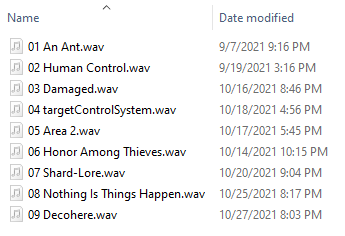I’m not in full-speed-ahead music recording mode, but I did record something that I definitely want on the next album. Pretty sure I’ve broken the curse. 🙂
People have been talking heavily again recently about materialism and “commodity fetishism” and so forth as it relates to modular. To me, general thoughts about this, and other peoples’ attitudes and issues are less fruitful to consider than an honesty check on my own part.
I could sell off all my Eurorack gear and still make music — at this point, it would even be fairly similar music. There are some specific sounds I wouldn’t achieve, sure, but I’d stick with modular-ish techniques (and hardware controllers) to a large extent, making use of Bitwig Grid and probably integrating some other software modular. The real question is, why would I? The only answers I can supply for that would be desperation, a radical change in living circumstances, or wanting to make a clean break artistically, I suppose.
Short of that, I could certainly reduce to a smaller case, but again, why? I like the case I have, with my spouse’s pyrography on the side, and just the right amount of space to be “a lot” without being overwhelming. Any pressure to reduce comes mainly from other peoples’ discourse about materialism.
With that said, I have been kind of wanting to lock down the gear again, stop thinking about making more changes and dig deep into some of the modules that deserve more exploration. But with a couple of caveats.
I reviewed the modules I have, categorizing some as “expendable” (with no surprises) and some as a sort of borderline, “interesting enough for now” (with a few surprises). In that group there is:
Loose Fruit: lackluster with some material, but very lustrous indeed with other material. A bit nicer than trying to patch the same effect with comparators and a switch. But it may be a bit of a one-trick pony at that. Not going to sell it off now, but it won’t surprise me if I let go of it later.
FM Aid: it’s cool, but I don’t use it a lot. I have a lot of FM capability among my various synths. I could consider it more for alternate waveshaping duties though, where it has some potential.
(Desmodus) Versio: some stunning effects, but there are also stunning effects in VST plugins — and in fact Noise Engineering is releasing some of the same effects that way. However, there’s new firmware on the way and the demo they gave was very much my spooky cup of tea, and there’s still potential for third-party firmware (or my own if I were to dig into it).
CVilization: The thing with this isn’t as much the cheat sheet necessity beyond basic operations, as it is a lot of functionality that I just don’t find myself wanting/needing much. The most common is the matrix mixer, though I am quite far from needing that in every patch either. After some further thought, simpler feedback patching tends to work pretty well; two 2:1 mono mixers can either do mono feedback with separate wet/dry and feedback control, or stereo feedback without the separate control, and that seems adequate to me. As it happens, Blinds can easily be two 2:1 mono mixers (and Shades one more, or other stuff…). So maybe this module, rather than Shades, is what I should sell off next.
FX Aid XL: it’s certainly a good module, with many fine sounding FX and constant updates! But again, VST plugins are my argument against it. I don’t really feel like there are unique and vital things it will do for me better than I can get elsewhere. It’s 6HP, Erfurt is 6HP, so if the Erfurt demos convince me I’ll make that change.
On my “expendable” list was Gozinta. I use it rarely, and can substitute other options when signals need a boost. I’ve decided to swap it out for Mutable Instruments Ears, which can boost a signal, has an internal piezo mic with textured panel and an envelope follower/gate — people love it with Rings and I’ve never tried it, and it seems like it could also inject creepy noises when processed in other ways (Beads, Mimeophon, reverbs) and act as a controller for other purposes.
New Systems Instruments Inertia is supposed to be released tomorrow; there are still no demos. There’s still some chance I may want to replace Maths with it, or it plus Tilt or Contour 1 or something. I really want to see those demos.
Otherwise, I’m on the edge of declaring a freeze again, for no specific duration. And then I may line up some projects to highlight specific modules, like I’ve done with Rings and Akemie’s Castle — the Ensemble Oscillator certainly deserves that treatment.

